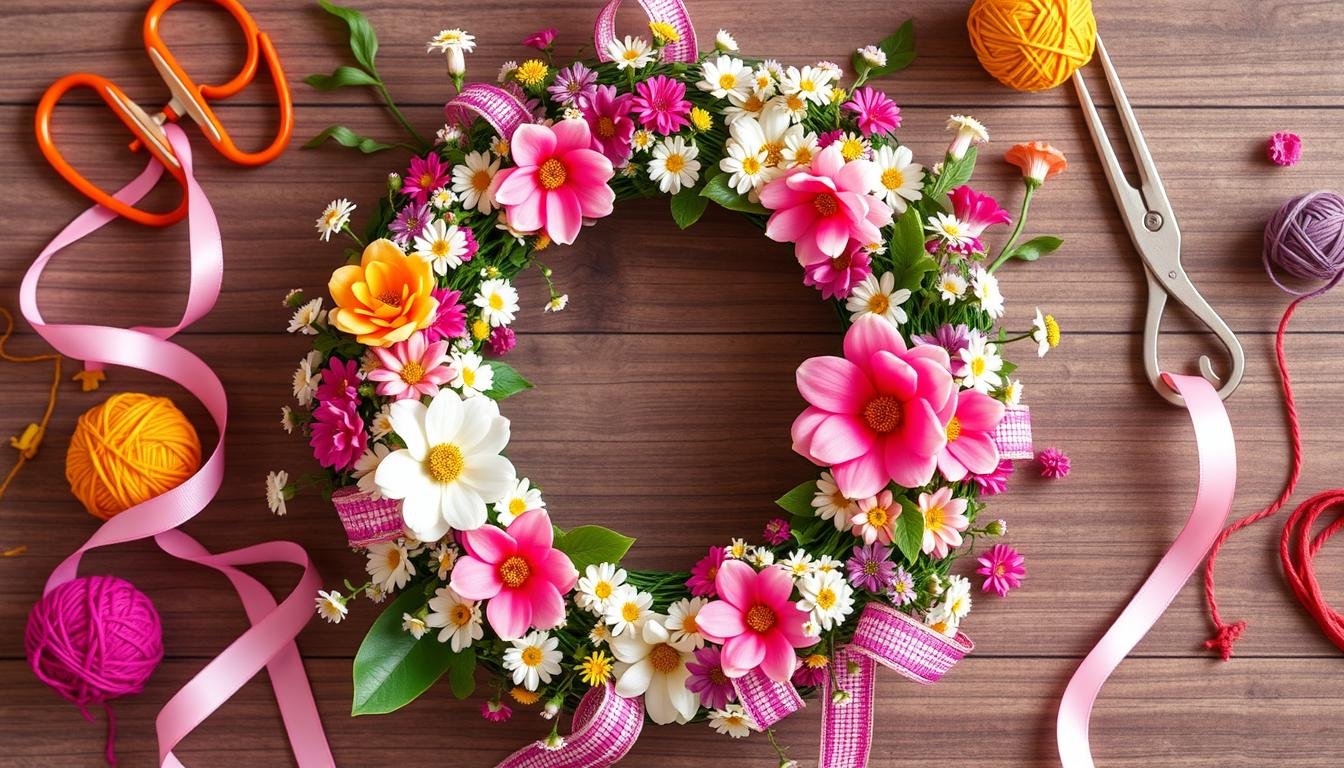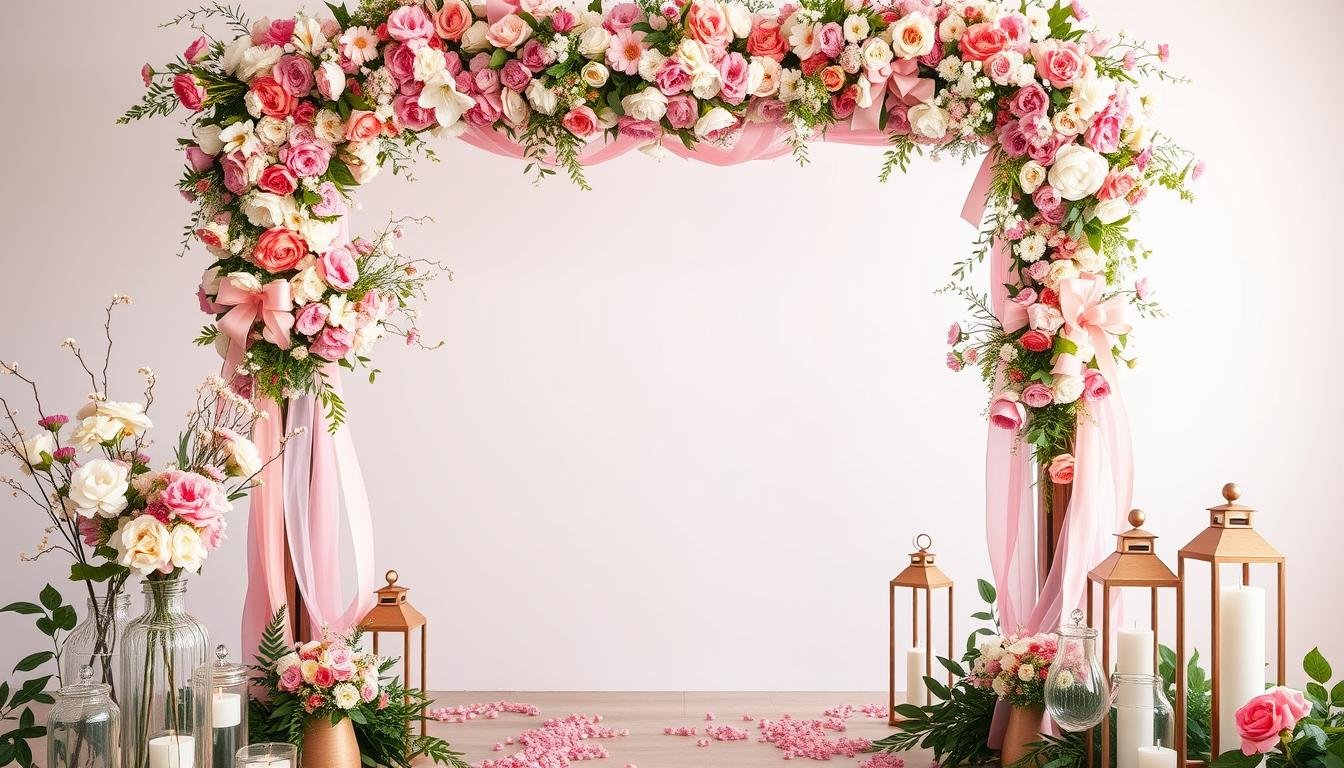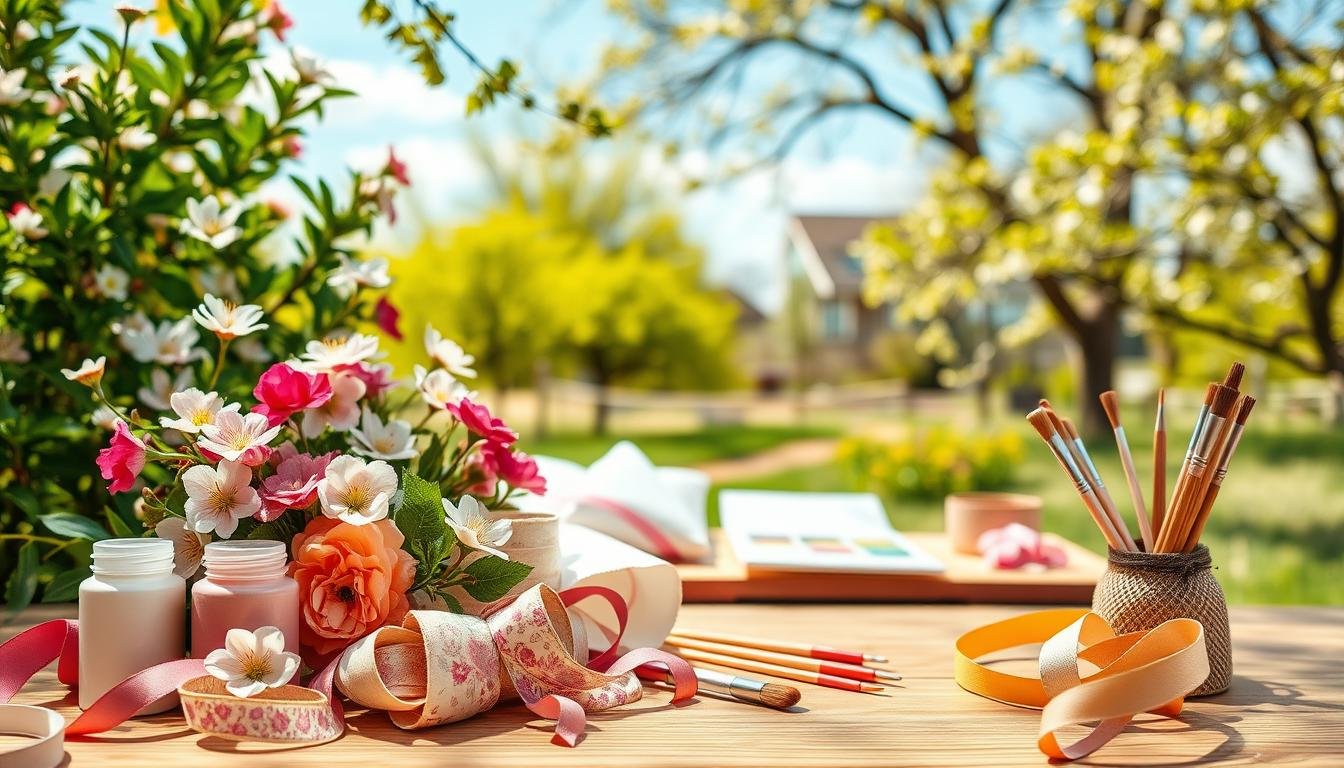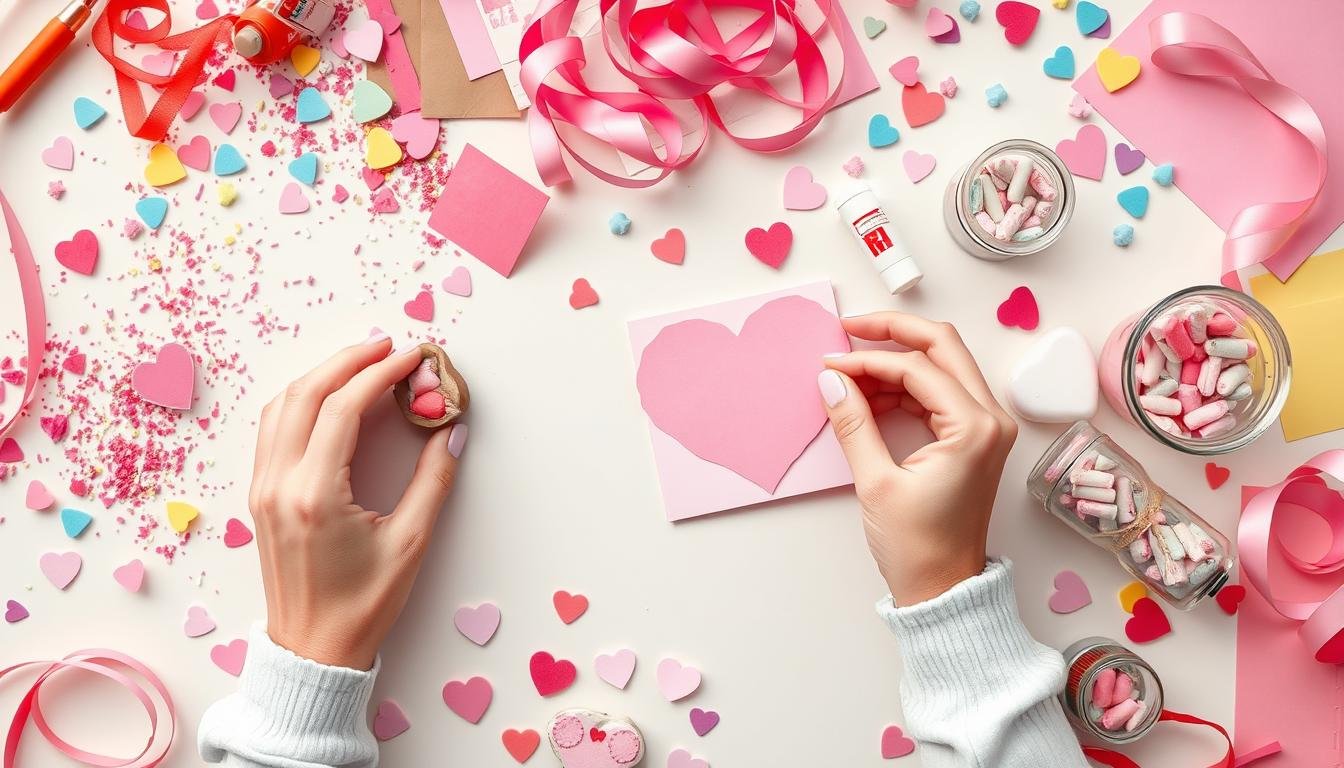Explore the Captivating History of Easter Egg Decorating with DIY Ideas
“The past is never dead. It’s not even past. It’s alive in everything we do.” — William Faulkner
As spring’s first blossoms bloom, so does the art of Easter egg decorating. This tradition, filled with ancient rituals, celebrates rebirth and renewal. It has traveled through time to become a beloved easter tradition.
In Ukraine, intricate Pisanki eggs tell stories of cultures and faiths. In Greece, red-dyed eggs symbolize sacrifice. Today, these easter eggs are not just old relics. They are canvases for creativity in kitchens and craft rooms around the world.
Key Takeaways
- The history of easter egg decorating spans over 700 years, blending pagan and Christian symbolism.
- Modern families spend 2-3 hours crafting eggs, with 70% of U.S. households participating annually.
- DIY methods like natural dyes from beets and turmeric honor eco-conscious trends while keeping traditions alive.
- Cultural symbols like Ukraine’s wax-resist Pisanki inspire today’s galaxy or glitter designs, proving heritage and creativity thrive together.
- Over 180 million eggs are decorated yearly in the U.S., showing how this tradition bridges past and present.
Imagine dyeing an egg with onion skins or decorating it with washi tape. Each step connects you to artisans from centuries ago. This article shows how the history of easter egg decorating & how it inspires diy can make your Easter special. It’s a mix of heritage and personal expression. Are you ready to see why your next DIY project is more than just color—it’s a conversation across time?
The Ancient Origins of Easter Egg Decoration
Ever wondered how easter eggs became such a timeless symbol? Let’s explore history that’s older than written language. Eggs have always been more than food—they’re tiny canvases of human creativity and belief.
Prehistoric Egg Symbolism and Decoration
Long before Easter, humans saw eggs as living miracles. Archaeologists found 65,000-year-old engraved ostrich eggshells in South Africa. These show our ancestors celebrated life’s beginnings through art.
These tiny masterpieces weren’t just decorations. They were prayers carved into shells. They connected us to a past where art and spirituality were one.
Egg Decorating in Early Pagan Spring Festivals
Pagan cultures celebrated spring’s return with egg rituals. Germanic tribes marked the vernal equinox by scratching patterns into shells. This practice is still used today.
Imagine ancient communities gathering to dye eggs with onion skins or berries. They believed these acts would ensure fertile crops and families. These spring rites laid the groundwork for modern easter traditions.
Transition to Christian Easter Traditions
When Christianity spread, eggs took on new meaning. By the 13th century, Christians dyed eggs red to symbolize Christ’s resurrection. Over time, vibrant hues like gold (for hope) and purple (for penance) joined the palette.
The Easter Bunny also has roots in Pennsylvania Dutch folklore. It’s a rabbit that laid eggs—a charming blend of old and new.
Next time you hold an egg, remember: you’re holding centuries of stories. What will your eggs tell future generations?
The History of Easter Egg Decorating & How It Inspires DIY
Imagine 5,000-year-old decorated ostrich eggs from ancient tombs, or King Edward I’s gold-leafed eggs in 1290. These aren’t just old relics—they’re guides for today’s creative Easter ideas. Let’s see how old traditions spark today’s DIY projects.
“Every brushstroke on an eggshell today whispers stories from the past,” says cultural historian Dr. Lena Torres. “Those patterns aren’t random—they’re living links to generations of crafters.”
Use the history of easter egg decorating as your guide. Try these classic methods with a modern twist:
- Wax Batik (Pysanky): Use beeswax and dye kits for geometric patterns, just like Ukrainians in the 17th century.
- Natural Dyeing: Use onion skins (since the 1600s) or coffee for natural colors instead of synthetic dyes.
- Egg Hunts with Purpose: Follow Martin Luther’s 1500s idea by hiding eggs to symbolize discovery and renewal.
| Historic Method | Modern DIY Twist |
|---|---|
| Gold-leafed eggs (1290) | Mod Podge + glitter for sparkle |
| Scratched designs (Trypillian era) | Toothpick etching on dyed eggs |
| Lenten egg fasting | Kid-friendly egg-citing recipes post-dyeing |
Don’t just decorate eggs. Try decorating wooden eggs or polymer clay replicas. Whether crafting with kids or exploring creative easter ideas, every project connects us to history. Ready to make history fun? Start decorating with dyes and let tradition spark your creativity!
Cultural Variations in Easter Egg Art Throughout History
Ever wondered how easter traditions turn simple eggs into symbols of heritage and art? Communities worldwide have made eggs into masterpieces. Each stroke and pattern tells their history. Let’s explore these global crafts for your next DIY project!
Ukrainian Pysanky: Intricate Wax-Resist Masterpieces
Ukrainian pysanky use hot wax to create intricate symbols. Symbols like sunbursts for protection and triangles for fertility. These eggs, now in Kolomyia’s museum, survived Soviet bans and inspire today’s crafters.
Try tracing their geometric patterns with a stylus and soy wax. It’s a modern take on an ancient art.
Polish Pisanki: Scratched and Etched Designs
In Poland, artists scratch away colored wax to reveal hidden hues. A nail or pin is used like a tool to uncover a puzzle. This “subtractive art” invites you to blend scratch techniques with floral wraps for layered effects.
Russian Imperial Eggs: From Folk Art to Fabergé
Russia’s 50+ Fabergé eggs show how folk crafts evolved into luxury. You might not have gemstones, but you can mimic their opulence with metallic paints and glued beads. The history of easter egg decorating lives in every glittery swirl!
German Egg Trees: Nature’s Canvas
In Bavaria, trees bloom with easter eggs instead of flowers. Hang hand-painted eggs on branches for a small-scale version. This tradition reminds us easter eggs aren’t just for hunts, but living art.
Whether you’re scratching wax or tying flower petals, these traditions prove creativity knows no borders. Dive into the history of easter egg decorating and let global techniques guide your next craft session. Your kitchen could become a studio for cultural revival!
Symbolic Meanings Behind Traditional Easter Egg Patterns
Ever wondered why certain shapes and colors appear on easter eggs? Each swirl, dot, and hue carries stories older than the eggs themselves. Let’s decode the language of symbols hidden in these vibrant holiday crafts.
Geometric spirals whisper eternity’s cycle. Sunbursts mirror life’s energy, while triangles guard against misfortune. In Ukrainian easter traditions, red signifies Christ’s blood and rebirth, green for growth, and black as a bridge to the afterlife. These aren’t just pretty patterns—they’re prayers, prayers etched in wax and dye.
- Spirals: Eternal cycles of nature
- Squares: Earth’s four corners or elements
- Triangles: Holy Trinity or protection
- Wavy lines: Rivers of life or water’s life-giving force
“The egg is the world in miniature,” wrote art historian Diane Morgan in Adorned Eggs, “a tiny canvas for humanity’s hopes and fears.”
Centuries ago, a zigzag line might’ve been a farmer’s plea for rain; today, you could use it to honor resilience. Try adding a sunburst on your easter eggs this year—its rays aren’t just decoration, but a nod to ancient spring festivals. What symbols would you choose to tell your family’s story?
These symbols are alive—adapt them, mix them, let them speak to your modern life. After all, every crack in the wax isn’t a mistake—it’s a crack in time, letting light in.
Evolution of Easter Egg Decorating Materials Through the Centuries
Ever wondered how the humble egg became a canvas for creativity across millennia? Let’s explore the changes in egg dyeing techniques—from natural to synthetic and back again.
“The first artists used what grew around them,” says historian Clara Bennett, “turning beetroot and onion skins into pigments.”
Before store-bought kits, the history of easter egg decorating used nature. Ancient people made gold with turmeric, crimson with madder roots, and brown with walnut shells. They even used calico fabric for patterns. Boiling eggs with spinach leaves made them green—a true diy projects start!
In the 1800s, chemistry introduced synthetic dyes. This allowed for bright colors like electric blues and neons. Now, we’re going back to earthy methods. Eco-friendly dyes and reusable wax let you be a medieval artist while saving the planet. Try using leftover coffee for a rustic look or beet juice with apple cider vinegar.
Want to mix old and new? Try onion-skin dyes with modern glue pens for layered designs. Your kitchen becomes a place of history and innovation. What will you create?
Classic Egg Dyeing Techniques Passed Down Through Generations
Ever wonder how ancestors made easter eggs into masterpieces? These egg dyeing techniques mix history with creativity. Let’s explore three methods that turn eggs into family treasures—perfect for your 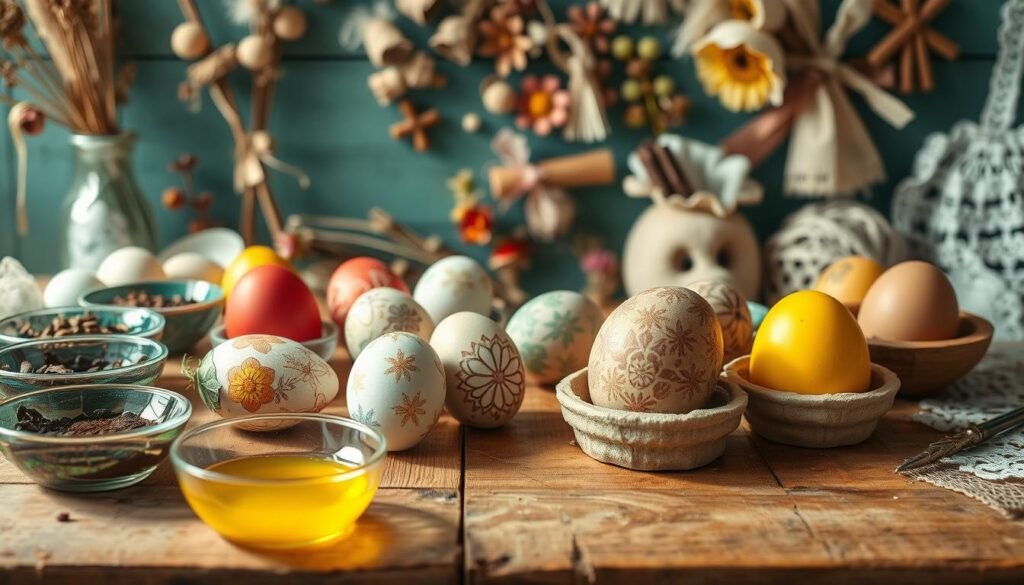
Hot Wax Batik: The Art of Ukrainian Pysanky
Imagine a kistka tool melting beeswax on an egg, stopping dye in certain spots. This pysanky craft from Ukraine goes back to the 1st century A.D. It features symbols like suns or trees. Here’s how it works:
- Start with clean eggs soaked in vinegar water (1 tbsp vinegar per quart)
- Draw designs with hot wax using a kistka pen
- Dip in light colors first, adding darker hues last—each layer reveals’s wax’s hidden patterns
These eggs can last centuries with protective varnish—making them family treasures.
Onion Skin Magic: Marbled Wonders
No synthetic dyes? No problem! Boil onion skins with water and vinegar for earthy hues. Follow these steps:
- Simmer 2 cups onion skins + 1 tbsp vinegar in 4 cups water for 30 minutes
- Submerge eggs until desired shade—darker soaking = deeper tones
Pro tip: Add copper wire twists for metallic accents—a modern twist on Slovenian traditions using onion dyes since the 17th century.
Floral Impressions: Nature’s Stamp
Press herbs or flowers onto eggs before dyeing—leaves ghostly imprints! Try these steps:
- Pat dry herbs (lavender, rose petals) onto eggs, securing with rubber bands
- Soak in dye baths (e.g., 20 drops blue + 2 red for violet)
- Peel off plants to reveal delicate patterns—nature’s own stamps!
Perfect for kids’ crafts, this technique honors the 2022-listed Slovenian Suhorje tradition of floral motifs.
These methods aren’t just crafts—they’re bridges to heritage. Grab a kistka, some onion peels, or your garden herbs. Let’s keep these traditions alive while adding our own flair!
Transitioning Historical Methods to Modern Homemade Decorations
Ever wondered how ancient egg-decorating wisdom can spark your homemade decorations? Let’s turn old techniques into DIY projects for today. Imagine Ukrainian wax-resist art with crayons—just draw patterns before dyeing for a kid-friendly twist. Swap beeswax for washi tape or metallic markers to blend tradition with modern flair.
- Use crayons to “resist” dye—perfect for family craft nights.
- Try creative easter ideas like temporary tattoo transfers for Victorian-inspired details.
- Repurpose grocery staples: onion skins for amber hues or coffee for earthy browns.
| Traditional Materials | Modern Alternatives |
|---|---|
| Beeswax | Washi tape |
| Plant dyes | Food-safe synthetic kits |
| Carving tools | Safety scissors + glue dots |
Even DIY projects like OOhh’s recycled paper eggs show sustainability is for everyone! Their zero-waste creations from expired newspapers blend eco-consciousness with history. With 40% more crafters using natural dyes today, tradition is thriving. Ready to mix beetroot juice with glitter glue? Your kitchen can be a workshop where heritage and innovation collide!
“Vintage doesn’t mean outdated—think of it as a palette to remix,” says Stylist Eddie Ross.
Whether you’re crafting an Easter tree with 6–12 dyed eggs or turning plastic eggs into year-round decor, every project connects past and present. Remember: there’s no “wrong” way to honor tradition when you infuse it with your own creativity. Let’s make history hands-on—your eggs, your rules!
Creative Easter Ideas Inspired by Historical Techniques
Ready to add ancient art to your Easter? Let’s dive into creative easter ideas that celebrate history and DIY fun! Whether you love diy projects or want new family traditions, these ideas make heritage fun and interactive.
“Tradition isn’t about copying the past—it’s about keeping its spirit alive through your own hands.”
Begin with egg dyeing techniques that mix old charm with easy kitchen items. Try marble eggs with nail polish: mix colors on water, dip eggs, and watch patterns appear. Or, use rubber bands for stripes or rice for texture. Paper doilies can create delicate designs!
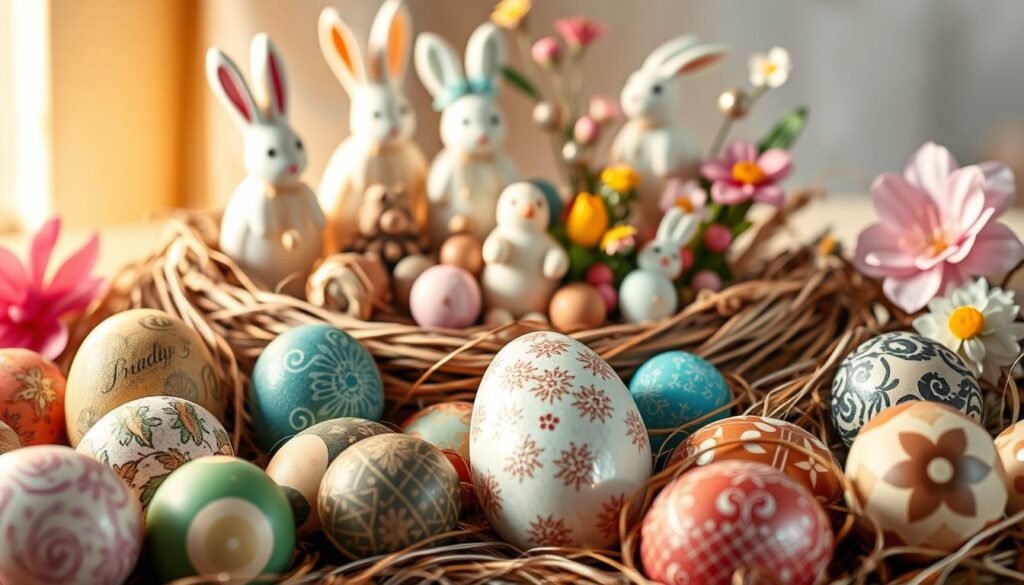
Try new spins on classic crafts. Use paint pens for pysanky patterns without wax. Add metallic stickers or washi tape for a Fabergé look. Kids can draw on dried glue-and-color coatings without sharp tools!
- Quick Swap: Use coffee grounds instead of onion skins for a different color.
- Family Fun: Make egg decorating a storytelling game, linking designs to cultural facts.
- Repurpose: Fill hollow eggs with confetti for a creative easter ideas twist on Mexico’s cascarones.
Every brush stroke or stamp connects you to history. These diy projects are more than crafts—they’re a bridge between past and present. Ready to make Easter your masterpiece?
How Social Media Has Transformed Traditional Easter Crafts
Ever wonder how egg decorating became so popular? Social media made holiday crafts a global topic. Sites like Instagram and Pinterest show creative easter ideas from everywhere. You can see Ukrainian pysanky and neon-dyed eggs from Tokyo side by side.
Platforms like Instagram have made 70% of users more likely to try homemade decorations. Companies like Twinkl’s Easter Celebration offer DIY tutorials. These videos can teach you to create detailed designs in just 10 minutes, says a craft influencer.
But it’s not just about getting likes. The #EggSwap2024 challenge turned decorating into a fun competition. People share their eggs, starting friendly competitions and cultural exchanges. This digital twist has:
- Increased DIY engagement by 25% (according to 2023 craft market data)
- Made natural dyes like beetroot pink or coffee-brewed browns popular again
- Pushed brands to offer eco-friendly kits, matching today’s values
Ready to share your eggs? Before posting, ask: Does this design tell my story or just follow trends? The best creative easter ideas mix new with old. Now go—your followers and future historians will appreciate it.
Conclusion: Preserving Heritage While Creating Your Personal Easter Traditions
The history of easter egg decorating is filled with ancient rituals and modern holiday crafts. Think of King Edward I’s 450 decorated eggs in 1290 or Cadbury’s 1897 Dairy Milk. These moments show how creativity blooms when old and new come together. This mix of easter traditions connects us across generations.
Why not blend Ukrainian pysanky patterns with your favorite kitchen tools? Or try onion-skin marbling while sharing Lent’s egg-fast history? The history of easter egg decorating sparks diy projects that honor the past and feel new. With Cadbury’s eggs and eco-friendly dyes, every egg tells a personal story.
As Easter in 2025 approaches on April 20, remember: those 80 million UK eggs bought yearly carry centuries of meaning. Whether you etch, roll eggs at the White House, or test a 10-minute dye bath, you keep heritage alive. Your family’s eggs might tell a story of tradition or innovation. Either way, you’re part of a timeless dance between past and present. Craft, share, and let your eggs carry your unique mark into tomorrow’s traditions.
FAQ
What is the significance of decorating Easter eggs?
How have traditional egg decorating methods evolved over time?
What are some popular cultural egg decorating traditions worldwide?
How can I incorporate symbols into my DIY Easter egg designs?
What materials can I use for egg decorating today?
Are there kid-friendly techniques for egg decorating?
How can social media influence my Easter egg decorating experience?
Source Links
- https://www.designandpaper.com/the-tradition-of-decorating-easter-eggs-a-diy-delight/
- https://www.mrsfields.com/blogs/blog/easter-egg-decorating-ideas
- https://kellystilwell.com/15-of-the-best-ideas-for-easter-egg-decorating/
- https://www.pureflix.com/insider/easter-egg-history-and-tradition
- https://blogs.loc.gov/folklife/2017/04/decorating-eggs/
- https://www.southernliving.com/holidays-occasions/easter/crafts/why-do-we-dye-easter-eggs?srsltid=AfmBOopfuqIWqmRepCFJgJ6XXlnk5LlE1ReKT3yMp7lj0t31U-XTzEre
- https://www.foxweather.com/lifestyle/easter-bunny-eggs-ancient-spring-traditions-christian-pagan
- https://saudereggs.com/blog/egg-decorating-around-the-world/
- https://www.glencairnmuseum.org/newsletter/2024/3/13/easter-eggs-symbols-of-rebirth-and-renewal
- https://en.wikipedia.org/wiki/Egg_decorating_in_Slavic_culture
- https://www.southernliving.com/holidays-occasions/easter/crafts/why-do-we-dye-easter-eggs?srsltid=AfmBOopHX_jSuqsxjVHgB_Ht1xgFSd5qlyR1B0yrGANH2mpp4uP4uPfb
- https://www.monasteryicons.com/product/story-of-the-first-easter-egg/did-you-know?srsltid=AfmBOoorTv-JILHZs_vnKqbRd6mQyRMWe11O-Ef7eZrMD4oKOPThVyda
- https://www.sweethampercompany.co.uk/blogs/news/the-history-of-the-easter-egg?srsltid=AfmBOoqKmtOjhjDdrEKwzkcMZ5USFIsdryCAwy6CHP_Vw1qLznYOkXeD
- https://www.english-heritage.org.uk/easter/preparing-for-easter-adventure-quests/how-to-decorate-easter-eggs/
- https://www.sewhistorically.com/history-of-the-easter-egg-easter-bunny/
- https://www.allrecipes.com/article/how-to-decorate-pysanky-ukrainian-easter-eggs/
- https://sloveniatimes.com/40369/easter-egg-decoration-an-art-passed-down-for-generations
- http://palatablepastime.com/2017/04/10/easter-egg-cooking-dyeing-tips-tricks/
- https://www.southernliving.com/holidays-occasions/easter/decor/easter-decorations?srsltid=AfmBOoqRXOv1zGdo6fluthBJap2yjciAt0Aco2RimQLKjZ8lp99TA8Qg
- https://www.formland.com/news-inspiration/article/beautiful-handmade-easter-eggs-made-from-the-oohh-zero-waste-paper
- https://www.bhg.com/holidays/easter/decorating/vintage-easter-decorations/
- https://www.boredpanda.com/easter-eggs-around-the-world/
- https://blog.loveable.us/blog/how-to-celebrate-easter-at-home/
- https://angiegensler.com/easter/
- https://www.ocoya.com/blog/easter-social-media-ideas
- https://freshjax.com/blogs/freshjax-blog/fun-and-easy-easter-crafts-for-the-whole-family?srsltid=AfmBOopXyRugX3C1_bygXNJ11jrF_MDsJV9iq7jV8HYiTdw5e39mqiOt
- https://www.boredpanda.com/creative-easter-eggs-designs/
- https://www.english-heritage.org.uk/easter/why-do-we-eat-eggs-at-easter/
- https://www.english-heritage.org.uk/visit/inspire-me/blog/articles/why-do-we-have-easter-eggs/
Jen is a healthcare pro by day and a DIY enthusiast by night, bringing creativity to life on JF Craft Corner! From decoupage to Cricut crafts, she’s all about making DIY magic (and a little mess). She also co-runs The Heart of Mindful Living blog and podcast, inspiring others to refresh their minds and nurture their souls. Her trusty sidekick? Fergus, her chocolate Shih Tzu and certified therapy dog, always on cuddle duty. Jen believes true leadership starts with kindness—and, of course, a little glitter!
